FOUNDATIONS REVEALED COMPETITION ENTRY

Change of Season Dress
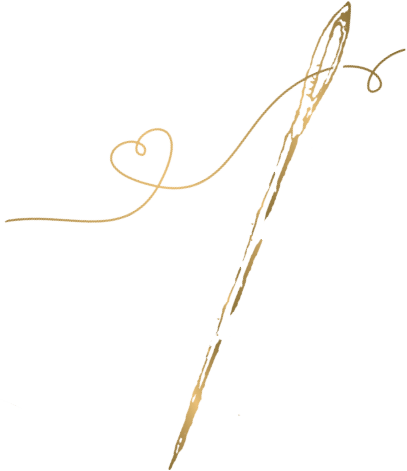
Outline the story …
Viewing the mood board, the words ‘change of season’ hooked me. Not being much of a ‘drawer’ I googled – change of season images, to see what I could reasonably draw onto the gored panels. I found an image of the same tree in the four distinct seasons: winter, spring, summer and autumn. I drew and coloured in the trees and their seasonal differences using ‘fabric paint pen’s.
The second reason for ‘change of season’ referred to my choice of second-hand fabric. All fabric must have been used previously and have been purchased/donated within my local area. The green of the bliaut was a Sheraton 100% cotton bed sheet and the blue arm bands and appliqued flowers came from a cotton/polyester doona cover ($6 from the St Helens District High School Op Shop). A 100% Indian cotton tablecloth and another doona cover was gifted from the local St Marys Repurposing & Upcycling group. Like frugal 12th century times, I made use of what I could source, going no further than 30 km’s for the fabric.
My final reason for ‘change of season’ referred to ‘time’. Instead of hand embroidering the trees, I needed a quick and easy alternative as I had no time for that much work. I felt that many women from the 12th century would have preferred ‘time saving techniques, such as fabric paint pens and metal grommets. Unfortunately, these were expensive and came from outside my local area.
Outline the construction…
The pattern was a combination of three ‘bliaut’ pattern/instructions I found on the internet. I started with the sleeves, cutting polyester fabric (from doona) for the floral armbands, and fusing it directly onto the green sleeve piece. This same fabric was used along the neckline; however this was trimmed to the shape of the flowers instead of being a panel. The flower sections were all joined together by a decorative satin stitch (by hand).
The godets were painted before being machine stitched in place. The front and back godets were really tricky. I disliked the ‘points’, so I made a feature of them by hand sewing a single appliqued flower at the junction. I then punched each of the grommets in place using ‘my eye’ instead of precise measurements. I had completed a ‘torso scale’ mock-up to ensure the correct fit.
I replicated the dress to create a lining. The necklines of the lining/main gown were whipped stitched together using green embroidery floss. I then hand stitched the lining, side lacing curve to the outside gown so there was no puckering. Finally, it was time for the hem and I did complete that twice, as the first time it ‘puckered. Instead, I made a cotton strip to match the strip on the sleeve hem and this made the dress fall beautifully and gave the gown a cohesive look. The strip was machine stitched and then folded over and hand stitched for an invisible finish.

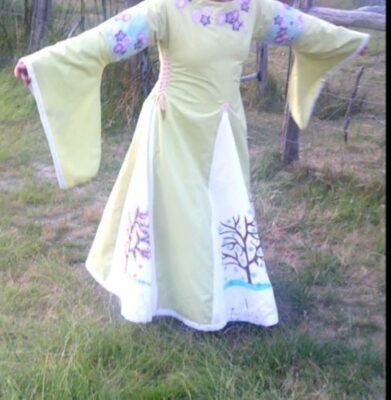
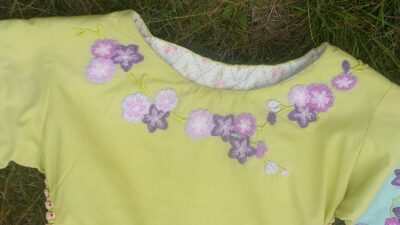
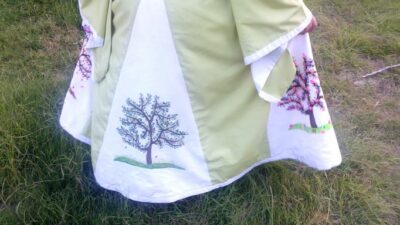
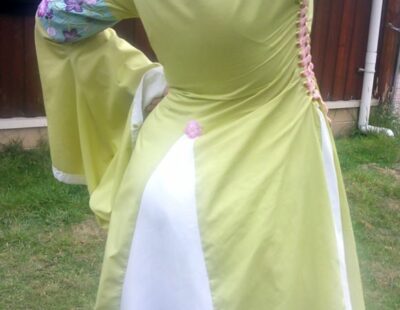
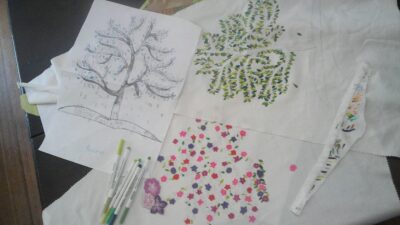
I love how you’ve combined all the different fabrics together. Great job!